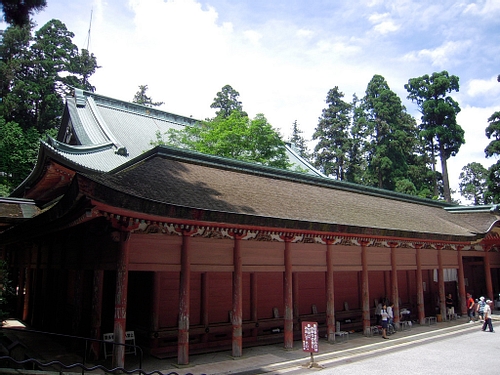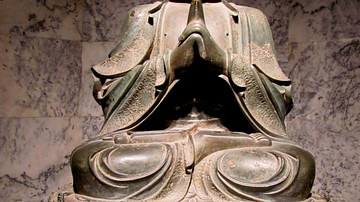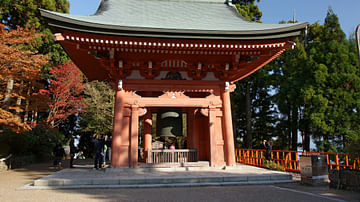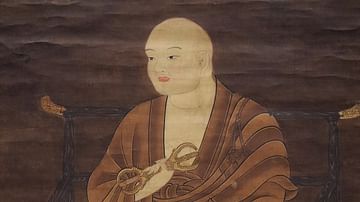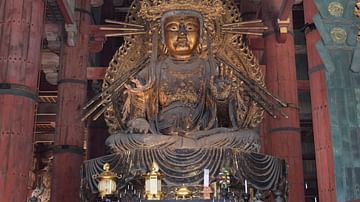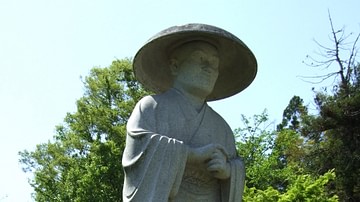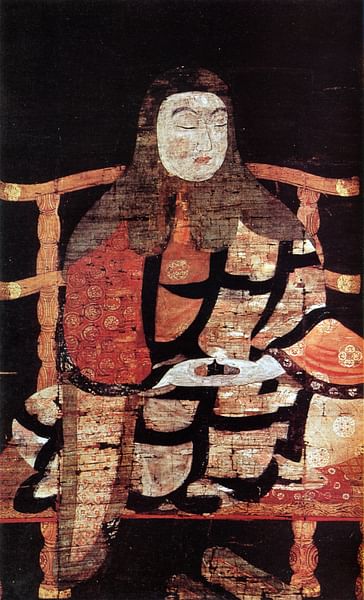
Saichō, also known as Dengyo Daishi (767-822 CE), was a monk and scholar who founded the Buddhist Tendai Sect in Japan. Based on the teachings of the Chinese Tiantai Sect, Saichō's simplified and inclusive version of Buddhism grew in popularity, and its headquarters, the Enryakuji temple complex on Mount Hiei, became one of the most important in Japan as well as a celebrated seat of learning.
Early Life
Saichō was born in 767 CE in Furuchi-go in Omi Province. He entered the Omi Kokubunji as a novice aged 11 and was tutored by the bishop Gyohyo. In 785 CE he was ordained as a monk. Three years later, disillusioned with the increasing worldliness in Buddhism, Saichō decided to live as an ascetic hermit on the slopes of Mount Hiei near Kyoto, a move not uncommon for priests of the period. There, in 788 CE, he built the first shrine of what would later become a huge temple complex. He began to study all he could on every variation of Buddhism and to attract followers, including two of his best-known disciples - Ensho and Gishin.
Saichō's reputation as a learned scholar grew, and in 797 CE he was made one of the ten court chaplains whose responsibility was to pray for the wellbeing of the state and its emperor. In 798 CE Saichō began what became a major series of annual lectures on Mount Hiei. The monk then visited Tang China in 804 CE as part of an official embassy sent by Emperor Kammu (r. 781-806 CE). There he studied four branches of Buddhism including Zen and Tiantai, which he was, by that time, already familiar with. He was initiated into the higher levels of the faith, studied texts of Mikkyo (Esoteric Buddhism), and brought back with him over 200 manuscripts and various implements for use in esoteric rituals.
Tendai Buddhism
Saichō sought to simplify the teachings of Buddhism, and on his return, he founded the eclectic Tendai Sect (Tendaishu) which was based on the Chinese Tiantai Sect and the Lotus Sutra (the last teachings of Buddha, aka the Hokekyo). Saichō believed that the best and quickest way to reach enlightenment was through esoteric ritual, that is rites which only the priesthood and initiated had access to. At the same time, the teachings of the Lotus Sutra allowed for many different ways to reach enlightenment and even women, under exceptional conditions, could attain Buddhahood. The historian R. H. P. Mason summarises the principles of Tendai Buddhism as follows:
Firstly, there was the bodhisattva ideal of compassion and service. Secondly, there was a benevolent attitude towards other forms of religion, including other forms of Buddhism. Thirdly, there was a belief in the eventual salvation of all beings. Fourthly, there was the idea that all life, and not just human life, was basically the same; that is, an idea of underlying unity of existence. (Mason, 102)
Imperial Endorsement
Tendai was not the only branch of Buddhism in Japan, and it had to compete with the well-established monasteries at the old capital of Nara and with new sects like Shingon Buddhism which was founded by the monk Kukai (774-835 CE) who had likewise just visited China. Nevertheless, the Tendai branch was eventually given royal approval by Kammu, and Saichō performed the first esoteric rites in Japan to receive official sponsorship in 805 CE. This sign of favour was due to the emperor being keen to diminish the political influence of the established monasteries and provide a common ground between the existing sects which were hostile to each other. Meanwhile, Saichō was eager for Buddhist followers and monks to actively help the state and not remain aloof from the economic problems of the day. Saichō believed in a close state-church partnership and he recommended his pupils not only study and live a monastic life but also help out with local farming, construction projects, and teaching duties. Below is an extract from his regulations for students of Tendai:
Students…shall be appointed to positions in keeping with their achievements after 12 years training and study. Those who are capable in both action and speech shall remain permanently on the mountain as leaders of the order: these are the treasure of the nation. Those who are capable in speech but not in action shall be teachers of the nation, and those capable in action but not in speech shall be the functionaries of the nation.
Teachers and functionaries…shall also serve in such undertakings which benefit the nation and people as the repair of ponds and canals, the reclamation of uncultivated land, the reparation of landslides, the construction of bridges and ships, the planting of trees…the sowing of hemp and grasses, and the digging of wells and irrigation ditches. They shall also study the Sutras, and cultivate their minds, but shall not engage in private agriculture or trading.
Two lay intendants will be appointed to this Tendai monastery to supervise it alternately, and to keep out robbers, liquor and women. Thus the Buddhist Law will be upheld and the nation safeguarded. (Mason, 100)
An independent Sect
Tendai Buddhism was unique from its Chinese parent Tiantai in that it incorporated esoteric rituals and initiations. Although all Buddhist sects were given value, Saichō still wrote in 813 CE his Ehyo Tendai shu which documented why Tendai was superior to all other branches of Buddhism. Saichō then compiled a new set of rules for ordaining Tendai priests in 818 CE, the Tendai Hokke-shu nembun gakusho shiki ('Bylaws for the Annual Ordinands of the Tendai Hokke School'), effectively breaking away from the established form of Buddhism in Japan. More proposals followed in 819 CE, which included the establishment of monasteries exclusively for Tendai monks (up to that time monasteries had hosted monks of varying branches of Buddhism). The Establishment in the form of the Office of Hierarchs fought these changes which led to Saichō producing his famous Kenkairon ('Treatise on the Precepts') which listed a 58-argument defence of why his proposals should be accepted. The conservative Hierarchs and Emperor Saga (r. 809-823 CE) would not budge though, even if Saichō was given the highest religious rank of dai hoshi.
Death & Legacy
On his death in 822 CE Saichō, given the honorary title Dengyo Daishi, was also considered a bodhisattva, that is, one who has reached nirvana but remains on earth to guide others. Shortly after his passing, Tendai was finally and formally established as a fully independent sect of Buddhism by the emperor acting independently of the Office of Hierarchs. The headquarters of Tendai Buddhism, which became even more popular after its founder's death, was the Enryakuji temple complex on Mount Hiei, and as Tendai encouraged the study of all Buddhist texts the complex, boasting up to 3,000 buildings and 25,000 residents in its heyday, became the major seat of learning in Japan. Tendai, perhaps inevitably given its broad range of eclectic beliefs, would, over the centuries, spawn other important Buddhist offshoots such as those of the Pure Land (Jodo) and Nichiren Sects.
This content was made possible with generous support from the Great Britain Sasakawa Foundation.
